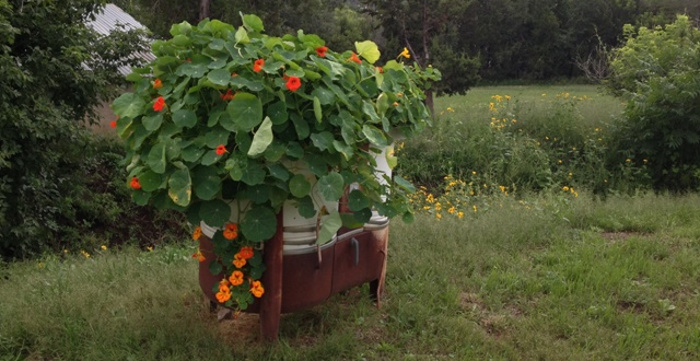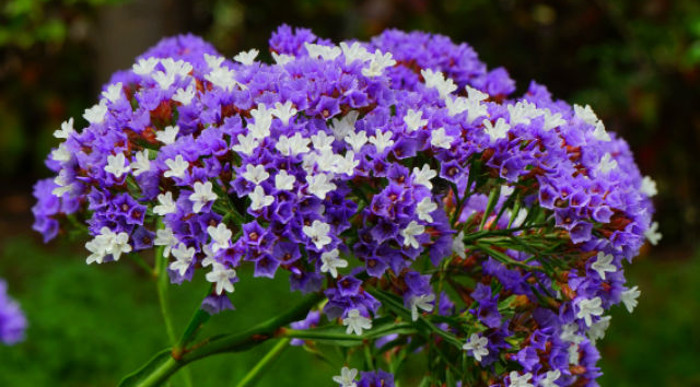It’s easy to have color in a low-water garden, but many xeric flowers and shrubs have stems too short or otherwise look better in your yard than in a vase. Here are 5 favorite plants that produce beautiful cut flowers but are also drought tolerant or resistant.
Coneflower
This is one of our favorite flowers, and we’d have one in our garden right now if a gopher had not destroyed the transplants we purchased at a local nursery. These are versatile flowers, tolerating both heat and drought, and growing in zones 3 through 9. They’re also gorgeous; coneflowers are in the daisy family, and I love how the rounded stamen, or center, rises above the petals. And it comes in many colors, including the traditional purple, along with yellow, white, raspberry and even in a mix with oranges and yellow that remind me of zinnias.
Echinacea also is a popular herb, and Native Americans have long used the plant’s extract to treat wounds and infections.

Coneflowers make striking cut flowers and attract pollinators to your garden.
Hyssop
This is another herb that uses little water and makes great cuttings. It’s called the “holy herb” for its purging or cleansing properties and the oil has aromatherapy uses. A member of the mint family, hyssop loves heat, but grows in zones 3 through 10. It’s deer resistant and drought tolerant. Pollinators love hyssop, so be sure to leave a few blooms on the plant. Hyssop is a perennial, and is evergreen or semi-evergreen in most zones. Most varieties produce mid-summer and late summer blooms in purple, blue, pink or white.

Hyssop blooms in summer, attracting pollinators.
Marigold
Although these members of the Asteraceae family don’t have the long stems of many cut flowers, they’re an easy, dependable and attractive annual. Most varieties come in yellow and orange. Technically not a drought-tolerant plant, marigold still thrives in well-drained soil in full sun from zones 2 through 10. To save water, I add marigolds to tomato plants or other areas of my vegetable garden. It’s said that their aroma can help deter insects. Pinching off the first few flowers before opening can help the plant produce more flowers for cutting.

Marigold blooms have such rich color and require only deadheading, or pinching spent blooms, to keep the blossoms coming.
Nasturtium
This tough flower does well in heat and poor, dry soil, and it’s edible. I love to see nasturtiums in containers, where the flowers drape over the sides. They’re easy to grow from seed, so that makes them affordable too! And the large seeds are easy to handle and space, so this is a great flower to have children help plant and then harvest. Although listed in zones 9 through 11, we’ve grown the flowers in zone 6B after summer warms up.

Nasturtium plants growing in an antique washer. We love the results!
Sea Lavender
I’ve never grown this pretty blue flower, although I love lavender. Maybe that’s because it prefers sandy soil that drains quickly and is a favorite of seaside areas. It’s not from the lavender family, but like lavender, Limonium does well in drier soils and drought conditions. The plant attracts birds and butterflies, and is easy to care for. Check with local nurseries or master gardeners to find the best variety for your zone, especially if you want to keep the plant as a perennial.

Sea lavender flowers are especially good at retaining color after cutting.
A few others that we like, that are both drought tolerant and good for cutting. Four o-clocks (Mirabilis) and periwinkle for low-water garden color.
Low-water Flowers To Cut and Arrange
A bouquet of flowers can make a special occasion much more special! But it’s also just fun to cut flowers from your own garden for table arrangements and a little bit of color and scent inside, especially on a cloudy day. Many xeric plants produce gorgeous, colorful blooms that you can cut for your vases. You’ll save water and money!
Gaillardia (blanket flower)
A popular wild annual that works well as a cut flower too.
Mexican Hat
This is another wildflower annual in New Mexico. The bloom is small, but different.
Native Rose
Perfect to cut a bloom or two for a tiny bud vase.
Coreopsis
These smaller, delicate flowers from the garden have reds, oranges and yellows perfect for brightening up an arrangement.
Cosmos
This colorful annual comes up each year from seed in whites, pinks and nearly purple. Mature plants are drought tolerant, and might even get leggy if they receive too much water.
Zinnia
Having zinnias in an arrangement gives you more size, shape and color choices. They grow easily from seed. Try to avoid watering them from overhead.
Of course, native plants often make good cut flowers and it never hurts to try a native wildflower from your region in an arrangement. If it’s a wildflower, chances are you’ll be seeing it again!
 |
Author Teresa Odle - Published 12-10-2020 |
